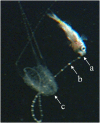Prey Capture Ecology of the Cubozoan Carukia barnesi
- PMID: 25970583
- PMCID: PMC4429964
- DOI: 10.1371/journal.pone.0124256
Prey Capture Ecology of the Cubozoan Carukia barnesi
Abstract
Adult Carukia barnesi medusae feed predominantly on larval fish; however, their mode of prey capture seems more complex than previously described. Our findings revealed that during light conditions, this species extends its tentacles and 'twitches' them frequently. This highlights the lure-like nematocyst clusters in the water column, which actively attract larval fish that are consequently stung and consumed. This fishing behavior was not observed during dark conditions, presumably to reduce energy expenditure when they are not luring visually oriented prey. We found that larger medusae have longer tentacles; however, the spacing between the nematocyst clusters is not dependent on size, suggesting that the spacing of the nematocyst clusters is important for prey capture. Additionally, larger specimens twitch their tentacles more frequently than small specimens, which correlate with their recent ontogenetic prey shift from plankton to larval fish. These results indicate that adult medusae of C. barnesi are not opportunistically grazing in the water column, but instead utilize sophisticated prey capture techniques to specifically target larval fish.
Conflict of interest statement
Figures





References
-
- Arai MN. A functional biology of Scyphozoa London: Chapman & Hall; 1997.
-
- Grossowicz M, Benayahu Y. Differential morphological features of two Dendraonephtjya soft coral special suggests differences in feeding niches. Marine Biodiversity. 2012; 42: 65–72. 10.1007/s12526-011-0093-0 - DOI
-
- Venn AA, Loram JE, Douglas AE. Photosynthetic symbioses in animals. Journal of Experimental Botany, Special Issue. 2008; 59; 1069–1080. - PubMed
-
- Brewer RH. The annual pattern of feeding, growth, and sexual reproduction in Cyanea (Cnideria: Scyphozoa) in the Niantic River Estuary, Connecticut. Biological Bulletin. 1989; 176(3): 272–281. Available: http://www.jstor.or/stable/1541985. - PubMed
Publication types
MeSH terms
Substances
LinkOut - more resources
Full Text Sources
Other Literature Sources

